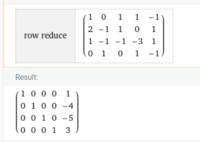Task: Show that the vectors [MATH]{(1,2,1,0),(0,-1,-1,1),(1,1,-1,0),(1,0-3,1)}[/MATH]A: can be used as a base in [MATH]R^4[/MATH]B: Find the coordinate for the vector [MATH](-1,1,1,-1)[/MATH] in this base.
A: I solved by first expressing the system of equation as follows:
[MATH](1): x_1+x_3+x_4=0 [/MATH][MATH](2): 2x_1-1x_2+x_3=0 [/MATH][MATH](3): x_1-x_2-x_3-3x_4=0 [/MATH][MATH](4): x_2+x_4=0 [/MATH]Now I solved it using Gauss elimination and eventually this will yield that the only solution is trivial, [MATH]x_1=x_2=x_3=x_4=0[/MATH] which shows that the system is linearly independent which implies that the four vectors can be used as a base in [MATH]R^4[/MATH].
For B I have no idea what I am supposed to do. My thought is maybe I should find my Transition matrix to convert the coordinates or am I just overcomplicating the problem massively?
A: I solved by first expressing the system of equation as follows:
[MATH](1): x_1+x_3+x_4=0 [/MATH][MATH](2): 2x_1-1x_2+x_3=0 [/MATH][MATH](3): x_1-x_2-x_3-3x_4=0 [/MATH][MATH](4): x_2+x_4=0 [/MATH]Now I solved it using Gauss elimination and eventually this will yield that the only solution is trivial, [MATH]x_1=x_2=x_3=x_4=0[/MATH] which shows that the system is linearly independent which implies that the four vectors can be used as a base in [MATH]R^4[/MATH].
For B I have no idea what I am supposed to do. My thought is maybe I should find my Transition matrix to convert the coordinates or am I just overcomplicating the problem massively?

